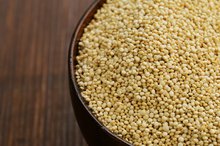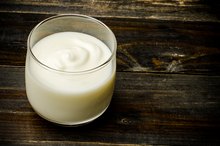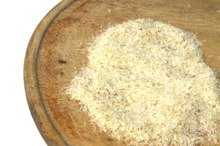What does fact checked mean?
At Healthfully, we strive to deliver objective content that is accurate and up-to-date. Our team periodically reviews articles in order to ensure content quality. The sources cited below consist of evidence from peer-reviewed journals, prominent medical organizations, academic associations, and government data.
The information contained on this site is for informational purposes only, and should not be used as a substitute for the advice of a professional health care provider. Please check with the appropriate physician regarding health questions and concerns. Although we strive to deliver accurate and up-to-date information, no guarantee to that effect is made.
Oatmeal & Headaches
Headaches that develop from eating oatmeal are uncommon and may be a sign of an allergic reaction. Although oatmeal is not a common food allergen, it may contain gluten, a protein that commonly triggers an allergic reaction from eating wheat, barely or rye. Other ingredients in the oatmeal may also trigger a food allergy, such as tree nuts, dairy or soy. Headaches that form from an allergic reaction to oatmeal are the result of sinus inflammation.
If you are experiencing serious medical symptoms, seek emergency treatment immediately.
Oatmeal Allergies
The University of Maryland Medical Center states that any food can trigger an allergic reaction that can result in a wide variety of symptoms 1. The cause of a food-related allergic reaction is an overly sensitive immune system to one or more of the proteins in the oatmeal. The immune system identifies the proteins as dangerous substances and a threat to the body and reacts by attacking the proteins. Immunoglobulin E antibodies trigger a chemical reaction throughout the body, causing white blood cells to produce histamine, according to the American Academy of Allergy, Asthma and Immunology. Histamine is a chemical that protects the body from infection but also increases inflammation.
- The University of Maryland Medical Center states that any food can trigger an allergic reaction that can result in a wide variety of symptoms 1.
- The immune system identifies the proteins as dangerous substances and a threat to the body and reacts by attacking the proteins.
Headache
What Is an Amaranth Allergy?
Learn More
The result of histamine released in nasal tissue is swelling and inflammation from increased blood flow. Shortly after eating oatmeal, you may develop a stuffy nose that is blocked by the swollen sinus tissue. Histamine also causes mucus membranes to increase the amount of mucus created in the nasal passages, which complicates the problem because the excessive mucus cannot drain out of the nose. These two actions create an abnormal amount of pressure throughout the head that causes pain. Sinus headaches primarily cause pain in the forehead and behind the eyes and cheekbones.
- The result of histamine released in nasal tissue is swelling and inflammation from increased blood flow.
- Histamine also causes mucus membranes to increase the amount of mucus created in the nasal passages, which complicates the problem because the excessive mucus cannot drain out of the nose.
Identification
Your doctor will recommend allergy testing to determine the exact protein that is triggering the allergic reaction that’s causing sinus pain. Skin tests are commonly performed to see how the skin reacts when a small amount of oat proteins are placed under your skin. If the skin becomes inflamed, develops bumps or becomes itchy, you may have an allergy. Blood tests will be performed to confirm and clinically diagnose which proteins cause an allergic reaction in your body.
- Your doctor will recommend allergy testing to determine the exact protein that is triggering the allergic reaction that’s causing sinus pain.
- Skin tests are commonly performed to see how the skin reacts when a small amount of oat proteins are placed under your skin.
Treatment
Wheat Grain & Eczema
Learn More
Once identified, you will be advised by your physician to eliminate all foods that contain the proteins that trigger an allergy. Sinus headaches are commonly treated with antihistamines to reduce histamine levels, decongestants to reduce swelling in the sinus tissues and pain relievers to alleviate any pain.
Related Articles
References
- University of Maryland Medical Center: Food Allergy
- MayoClinic.com: Sinus Headache
- American Academy of Otolaryngology: Sinus Headaches
- Aydemir L, Doruk C, Çaytemel B, Şahin B, Şahin E, Çelik M, et al. Paranasal sinus volumes and headache: is there a relation? Eur Arch Otorhinolaryngol. 2019 May 16. doi: 10.1007/s00405-019-05461-1.
Writer Bio
Diane Marks started her writing career in 2010 and has been in health care administration for more than 30 years. She holds a registered nurse license from Citizens General Hospital School of Nursing, a Bachelor of Arts in health care education from California University of Pennsylvania and a Master of Science in health administration from the University of Pittsburgh.








